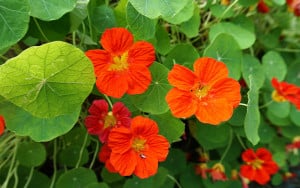Companion planting is a traditional way of gardening, doing so organically without the need to use chemicals because the plants do the job! Rather than relying on chemicals, certain plants work together to improve the health of others when grown nearby and can even lead to better tasting crops.
There are several ways this can work. Some companion plants have the purpose of attracting beneficial insects, some improve the nutrients of the soil, whilst others repel pests, or act as a decoy. On the other hand, some are sacrificial crops to attract pests to, so they don’t munch away on your prized plants.
Sacrificial crops
Provide a meal for the pests so they don’t want to dine on your delightful harvests.
For example, cabbage white caterpillars enjoy cabbages and other brassicas as well as turnips and swedes. Plant Tropaeolum majus (nasturtiums) nearby as a sacrificial crop and they will choose the bright flowers over the cabbages to keep your crops safe.

These flowers are also beneficial to have near Brussels sprouts too, because caterpillars and cabbage root fly quite like a sprout. Another way to keep your sprouts safe and secure is to plant Calendula officinalis (pot marigold) to attract slugs. Once the slugs make their way to the marigolds, you’ll be able to see their trails so you can physically remove them.
Its useful to also plant bright flowers around crops to attract beneficial insects that will prey on any aphids.
Deterring pests

Repel pests away by planting strong-smelling plants that will make the smell of their favourite crops. Choose marigolds to deter whitefly from cucumbers, repelling aphids from runner beans, whilst attracted lacewings and ladybirds to the vicinity who prey on aphids.
Allium tuberosum (garlic chive) has a strong scent and will confuse the carrot root fly when planted near to carrots.
Planting garlic chives means you also have an easily accessible stock of chives to use in the kitchen for some extra flavour especially as they’re evergreen.
Plant basil next to peppers to repel aphids.
Attracting wildlife
Utilise plants to encourage beneficial bugs into your garden that will feast on pests that are in the area.
Not only can you enjoy the fragrance and beautiful flowers of lavender, but it is incredibly popular with pollinators too. The strong scent deters aphids, so plant it next to leeks and carrots to confuse the pest; as if you needed a reason grow lavender in the garden!

Put it to practice

Here are a few common crops to use as companions in the garden, and plants to avoid:
• Improve the growth of leek by planting them with carrots, celery, onions and spinach. But, avoid planting near beans and peas. The leeks will benefit the other veg by repelling carrot root fly.
• Potatoes thrive when planted near marigolds, cabbage, and beans because they improve the growth and taste. However, keep them away from cucumbers and squash because they can become more susceptible to blight.
• Grow the best onions by growing carrots, lettuce, and cabbage nearby, but avoid planting beans and peas nearby because onions release a chemical that can inhibit nitrogen production by the beans and peas.
• Pea-family plants such as lupins, beans, peas, and sweet peas benefit the soil as they take nitrogen from the air and store it in their roots. So, beans are generally suggested as a companion for many leafy nitrogen loving vegetables such as cucumbers, corn, and broccoli.

Leave A Comment